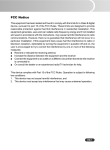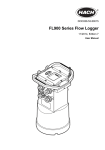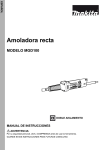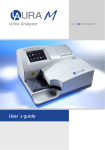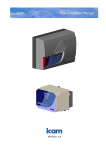Download Manual - Bacharach, Inc.
Transcript
Gas Detector and Controllers Installation and Operation Manual Instruction 6109-9000 Revision 4 – June 2014 Product Leadership • Training • Service • Reliability MGD-100 Manual WARRANTY POLICY BACHARACH, INC. WARRANTS THIS INSTRUMENT, EXCLUDING SENSORS, TO BE FREE FROM DEFECTS IN MATERIALS AND WORKMANSHIP FOR A PERIOD OF ONE YEAR FROM THE DATE OF PURCHASE BY THE ORIGINAL OWNER. THE SENSORS HAVE A WARRANTY PERIOD OF ONE YEAR FROM THE DATE OF PURCHASE. IF THE PRODUCT SHOULD BECOME DEFECTIVE WITHIN THIS WARRANTY PERIOD, WE WILL REPAIR OR REPLACE IT AT OUR DISCRETION. THE WARRANTY STATUS MAY BE AFFECTED IF THE INSTRUMENT HAS NOT BEEN USED AND MAINTAINED PER THE INSTRUCTIONS IN THIS MANUAL OR HAS BEEN ABUSED, DAMAGED, OR MODIFIED IN ANY WAY. THIS INSTRUMENT IS ONLY TO BE USED FOR PURPOSES STATED HEREIN. THE MANUFACTURER IS NOT LIABLE FOR AUXILIARY INTERFACED EQUIPMENT OR CONSEQUENTIAL DAMAGE. DUE TO ONGOING RESEARCH, DEVELOPMENT, AND PRODUCT TESTING, THE MANUFACTURER RESERVES THE RIGHT TO CHANGE SPECIFICATIONS WITHOUT NOTICE. THE INFORMATION CONTAINED HEREIN IS BASED ON DATA CONSIDERED ACCURATE. HOWEVER, NO WARRANTY IS EXPRESSED OR IMPLIED REGARDING THE ACCURACY OF THIS DATA. ALL GOODS MUST BE SHIPPED TO THE MANUFACTURER BY PREPAID FREIGHT. ALL RETURNED GOODS MUST BE PRE-AUTHORIZED BY OBTAINING A RETURN MERCHANDISE AUTHORIZATION (RMA) NUMBER. CONTACT THE MANUFACTURER FOR A NUMBER AND PROCEDURES REQUIRED FOR PRODUCT TRANSPORT. SERVICE POLICY BACHARACH, INC. MAINTAINS AN INSTRUMENT SERVICE FACILITY AT THE FACTORY. SOME BACHARACH DISTRIBUTORS / AGENTS MAY ALSO HAVE REPAIR FACILITIES, HOWEVER, BACHARACH ASSUMES NO LIABILITY FOR SERVICE PERFORMED BY ANYONE OTHER THAN BACHARACH PERSONNEL. REPAIRS ARE WARRANTED FOR 90 DAYS AFTER DATE OF SHIPMENT (SENSORS, PUMPS, FILTERS AND BATTERIES HAVE INDIVIDUAL WARRANTIES). SHOULD YOUR INSTRUMENT REQUIRE NON-WARRANTY REPAIR, YOU MAY CONTACT THE DISTRIBUTOR FROM WHOM IT WAS PURCHASED OR YOU MAY CONTACT BACHARACH DIRECTLY. IF BACHARACH IS TO DO THE REPAIR WORK, SEND THE INSTRUMENT, PREPAID, TO BACHARACH, INC. AT THE FOLLOWING ADDRESS. BACHARACH, INC. 621 HUNT VALLEY CIRCLE NEW KENSINGTON, PA 15068 ATTENTION: SERVICE DEPARTMENT ALWAYS INCLUDE YOUR RMA #, ADDRESS, TELEPHONE NUMBER, CONTACT NAME, SHIPPING/BILLING INFORMATION AND A DESCRIPTION OF THE DEFECT AS YOU PERCEIVE IT. YOU WILL BE CONTACTED WITH A COST ESTIMATE FOR EXPECTED REPAIRS PRIOR TO THE PERFORMANCE OF ANY SERVICE WORK. FOR LIABILITY REASONS, BACHARACH HAS A POLICY OF 2 6109-9000 Rev 4 MGD-100 Manual PERFORMING ALL NEEDED REPAIRS TO RESTORE THE INSTRUMENT TO FULL OPERATING CONDITION. PRIOR TO SHIPPING EQUIPMENT TO BACHARACH, CONTACT OUR OFFICE FOR AN RMA # (RETURNED MERCHANDISE AUTHORIZATION). ALL RETURNED GOODS MUST BE ACCOMPANIED WITH AN RMA NUMBER. PACK THE EQUIPMENT WELL (IN ITS ORIGINAL PACKING IF POSSIBLE), AS BACHARACH CANNOT BE HELD RESPONSIBLE FOR ANY DAMAGE INCURRED DURING SHIPPING TO OUR FACILITY. NOTICES COPYRIGHTS: THIS MANUAL IS SUBJECT TO COPYRIGHT PROTECTION; ALL RIGHTS ARE RESERVED UNDER INTERNATIONAL AND DOMESTIC COPYRIGHT LAWS. THIS MANUAL MAY NOT BE COPIED OR TRANSLATED, IN WHOLE OR IN PART, IN ANY MANNER OR FORMAT, WITHOUT THE WRITTEN PERMISSION OF BACHARACH, INC. ALL SOFTWARE USED AND/OR DISTRIBUTED BY BACHARACH IS SUBJECT TO COPYRIGHT PROTECTION. ALL RIGHTS ARE RESERVED. NO PARTY MAY USE OR COPY SUCH SOFTWARE IN ANY MANNER OR FORMAT, EXCEPT TO THE EXTENT THAT BACHARACH GRANTS THEM A LICENSE TO DO SO. IF THIS SOFTWARE IS BEING LOADED ONTO MORE THAN ONE COMPUTER, EXTRA SOFTWARE LICENSES MUST BE PURCHASED. TECHNICIAN USE ONLY THIS UNIT MUST BE INSTALLED BY A SUITABLY QUALIFIED TECHNICIAN WHO WILL INSTALL THIS UNIT IN ACCORDANCE WITH THESE INSTRUCTIONS AND THE STANDARDS IN THEIR PARTICULAR INDUSTRY/COUNTRY. OPERATORS OF THE UNIT SHOULD BE AWARE OF THE REGULATIONS AND STANDARDS IN THEIR INDUSTRY/COUNTRY FOR THE OPERATION OF THIS UNIT. THESE NOTES ARE ONLY INTENDED AS A GUIDE AND THE MANUFACTURER BEARS NO RESPONSIBILITY FOR THE INSTALLATION OR OPERATION OF THIS UNIT. FAILURE TO INSTALL AND OPERATE THE UNIT IN ACCORDANCE WITH THESE INSTRUCTIONS AND WITH INDUSTRY GUIDELINES MAY CAUSE SERIOUS INJURY INCLUDING DEATH AND THE MANUFACTURER WILL NOT BE HELD RESPONSIBLE IN THIS REGARD. 6109-9000 Rev 4 3 MGD-100 Manual Table of Contents SECTION 1. OVERVIEW ................................................................................ 5 1.1. General Information ................................................................................ 5 1.2. Technical Specifications ........................................................................ 10 SECTION 2. 2.1. 2.2. 2.3. 2.4. 2.5. 2.6. PLACING SENSORS .................................................................. 13 Installation Warnings ............................................................................ 13 General Guidelines ................................................................................ 13 Machinery Rooms ................................................................................. 15 Refrigerated Spaces............................................................................... 16 Chillers ................................................................................................... 16 Air Conditioning (Direct Systems VRF/VRV) .......................................... 17 SECTION 3. HOUSING DIMENSIONS .......................................................... 18 SECTION 4. WIRING INSTRUCTIONS .......................................................... 23 4.1. 4.2. 4.3. 4.4. 4.5. Wiring MGD-100s .................................................................................. 23 External Audible Alarm .......................................................................... 24 DC Output .............................................................................................. 24 Relays .................................................................................................... 25 Power Connection ................................................................................. 25 SECTION 5. OPERATION AND STABILIZATION ............................................ 30 SECTION 6. FUNCTIONAL TESTS AND CALIBRATION .................................. 32 6.1. 6.2. 6.3. 6.4. 6.5. 6.6. 6.7. Introduction .......................................................................................... 32 Electrical Reset ...................................................................................... 34 Bump Testing ......................................................................................... 35 Calibration Overview ............................................................................. 38 Calibration Options ............................................................................... 38 Sensor Board Exchange ......................................................................... 38 On-Site Gas Calibration ......................................................................... 39 SECTION 7. TROUBLESHOOTING ............................................................... 41 DECLARATION OF CONFORMITY .................................................................... 43 4 6109-9000 Rev 4 MGD-100 Manual Section 1. Overview 1.1. General Information The MGD-100 is the ideal gas detection solution for installations requiring a quality and affordable stand-alone gas detector. It consists of 1 to 6 remote gas sensors connected to and powered by a controller. The controller provides visual, audible, and relay alarms on the detection of gases. The system is available with one or two levels of alarm. The MGD-100 can be used for: • • • detecting refrigerant gases (including NH3 and CO2) speedy detection of combustible gases detection of toxic and VOC gases. A range of gas detector and sensor enclosures are available for special applications. The MGD-100 Controller is required. With the MGD-100, it creates a stand-alone gas detection system and is used to remotely monitor up to six MGD-100 devices. Models are available with 1, 2, 4, and 6 channels. Wiring diagrams are provided later in this manual. 6109-9000 Rev 4 5 MGD-100 Manual Figure 1. MGD-100 1- and 2-Channel Controller PCB (Single Level Alarm) Figure 2. MGD-100 1- and 2-Channel Controller PCB (Dual Level Alarm) 6 6109-9000 Rev 4 MGD-100 Manual Figure 3. MGD-100 4- and 6-Channel Controller PCB (Single Level Alarm) 6109-9000 Rev 4 7 MGD-100 Manual Figure 4. MGD-100 4- and 6-Channel Controller PCB (Dual Level Alarm) 8 6109-9000 Rev 4 MGD-100 Manual Figure 5. Examples MGD-100 PCBs 6109-9000 Rev 4 9 MGD-100 Manual 1.2. Technical Specifications Specification Description Power Supply 100 - 230 VAC 50 - 60 Hz, or 12 VDC (specified at time of order) Alarm Silence Key Switch Alarm Delay Preset: 25 sec (low), 30 sec (high) Power Monitoring LED Green Alarm Relay(s) 10 A, 120V/230V Warm-up Delay Minimum of 3 minutes Communications Wiring 4-conductor cable (stranded); 500 ft (152 m) max; 22 AWG; Max 8.8Ω/wire Approvals UL/CSA/IEC/EN 61010-1; CE Sensor Channels 1- and 2-channel systems 4- and 6-channel systems 15 W 25 W Max Power Alarm Levels 1 Level 2 Levels 1 Level 2 Levels Audible Alarm (Buzzer) Internal, continuous Internal, intermittent (low), continuous (high) Internal, continuous Internal, intermittent (low), continuous (high) Alarm Reset Automatic Automatic (low alarm), manual (high alarm) Automatic Automatic (low alarm), manual (high alarm) Visual Alarm LED(s) Red Yellow, Red Red Yellow, Red Fault Indication(s) Red LED Red LED Red LED Red LED, relay 10 6109-9000 Rev 4 MGD-100 Manual Specification Description 1- and 2-chan systems Std. Enclosure Ratings Dimensions and Weight: Controller Sensor Dimensions and Weights 4- and 6-chan systems MGD: IP41 Controller: IP51 MGD: IP41 Controller: IP51 8.4” x 4.1” x 3.15” 214 x 105 x 80 mm 2.2 lbs / 1.0 kg 10.3” x 10.4” x 303” 262 x 265 x 84 mm 5.1 lbs / 2.3 kg Type/Enclosure Dimensions Weights IP41 3.35” x 5.59” x 2.09” 86 x 142 x 53 mm 6.3 oz 180 g IP66 6.89” x 6.5” x 3.29” 175 x 165 x 82 mm 1 lb 6 oz 629 g IP66 w/ Splash Guard 6.89” x 8.9” x 3.29” 175 x 225 x 82 mm 1 lb 9 oz 700 g IP66 w/ Remote Sensor 6.89” x 6.1” x 3.29” 175 x 155 x 82 mm 1 lb 11 oz 790 g IP66 w/ Exd Remote Head 6.89” x 6.1” x 3.29” 175 x 155 x 82 mm 2 lb 10 oz 1185 g IP66 w/ PRV Sensor Head 6.89” x 6.1” x 3.29” 175 x 155 x 82 mm 2 lb 0.3 oz 916 g IP66 Airflow/ Duct (See Table) 6.89” x 4.9” x 3.29” 175 x 125 x 82 mm 1 lb 4 oz 578 g Exd (ATEX only) 5.12” x 6.3” x 3.54” 130 x 160 x 90 mm 9 lb 4 oz 4200 g NOTE: The hazardous area Exd Gas Monitor products are designed with individually certified Exd main housing enclosures and certified Exd remote or attached sensor enclosures. The main housing enclosure and its PCB assembly are also Exd certified, but the final Exd Gas Monitor assemblies (main enclosure and/or sensor assembly) are not currently Exd certified, but are pending additional testing. 6109-9000 Rev 4 11 MGD-100 Manual Supported CFM and Duct Sizes for the Duct Mount Housing Units Duct Size Inches 12 x 12 12 x 24 18 x 18 24 x 24 24 round Feet 1x1 1x2 1.5 x 1.5 2x2 Pi x 1 x 1 Area (ft2) 1 2 2.25 4 3.14 CFM 12 Ft/min (Based on CFM and Duct Size) 2800 2800 n/a n/a n/a n/a 3000 3000 n/a n/a n/a n/a 3400 3400 n/a n/a n/a n/a 3800 3800 n/a n/a n/a n/a 4000 4000 n/a n/a n/a n/a 4400 4400 n/a n/a n/a n/a 4800 4800 n/a n/a n/a n/a 5000 5000 2500 n/a n/a n/a 5400 5400 2700 n/a n/a n/a 5800 5800 2900 2578 n/a n/a 6000 6000 3000 2667 n/a n/a 6400 6400 3200 2844 n/a n/a 6800 6800 3400 3022 n/a n/a 7000 7000 3500 3111 n/a n/a 7400 7400 3700 3289 n/a n/a 7800 7800 3900 3467 n/a n/a 8000 8000 4000 3556 n/a 2548 8400 8400 4200 3733 n/a 2675 8800 8800 4400 3911 n/a 2803 9000 9000 4500 4000 n/a 2866 9400 9400 4700 4178 n/a 2994 9800 9800 4900 4356 n/a 3121 10000 10000 5000 4444 2500 3185 6109-9000 Rev 4 MGD-100 Manual Section 2. Placing Sensors 2.1. Installation Warnings NOTE: This instrument can be equipped with a semiconductor sensor for the detection of refrigerant, combustible and VOC gases. Semiconductor sensors are not gas specific and respond to a variety of other gases including propane exhaust, cleaners, and solvents. Changes in temperature and humidity may also affect the sensor’s performance. WARNING: Explosion hazard! Do not mount the MGD-100 in an area that may contain flammable liquids, vapors, or aerosols. Operation of any electrical equipment in such an environment constitutes a safety hazard. CAUTION: The MGD-100 contains sensitive electronic components that can be easily damaged. Do not touch nor disturb any of these components. NOTE: The mounting location of the monitor should allow it to be easily accessible for visual monitoring and servicing. NOTE: The monitor must be connected by a marked, suitably located and easily reached switch or circuit-breaker as means of disconnection. NOTE: Connect monitor power and signaling terminals using wiring that complies with local electrical codes or regulations for the intended application. 2.2. General Guidelines NOTE: The MGD-100 should be installed plumb and level and securely fastened to a rigid mounting surface. The MGD-100 controller and its sensor(s) should be positioned carefully to avoid mechanical damage (from moving machinery, doors, etc.) and thermal extremes (close to heaters). Units should not be placed unprotected in direct strong drafts/airflows and areas where water or moisture is present unless an appropriate enclosure is used. 6109-9000 Rev 4 13 MGD-100 Manual Avoid routing sensor cabling outside of premises, or between buildings via overhead cables. Also, sensor wiring should be kept to a minimum of 20 in (500mm) from the main power supply and telephone cables. When connecting the main power supply and/or sensor cables ensure a second mechanical fixing is used. Use a cable tie inside the enclosure within 1 in (25mm) of the cable termination. When power to the unit is switched on, there is a 3-minute delay before the system activates. This allows the sensors to warm up to the correct temperature for gas detection. On a two-alarm unit, the green light on the alarm panel comes on after the delay, indicating that the system is ready. On a one-alarm system the green light comes on immediately. When a unit has been off or stored for a long time the stabilizing period may be longer than 3 minutes. After the 3 minutes has expired, alarms may activate. You may deactivate the siren until stabilization is complete. (Use the key switch on two-alarm units. Remove jumper JP1 in the case of a one-alarm unit). Mount the controller using the mounting holes in the base such that the sensor cable terminal blocks are at the bottom of the unit in a convenient position. Sensors must be located within the appropriate wire lengths from the controller. In all cases the sensor supplied is designed for maximum sensitivity to a particular gas. However, in certain circumstances false alarms may be caused by the occasional presence of sufficiently high concentrations of other gaseous impurities. Examples of situations where such abnormalities may arise include the following: • • • Plant room maintenance activity involving solvent or paint fumes or refrigerant leaks. Accidental gas migration in fruit ripening/storage facilities (bananas - ethylene, apples - carbon dioxide). Heavy localized exhaust fumes (carbon monoxide, dioxide, propane) from engine-driven forklifts in confined spaces or close to sensors. A sensor response delay is built in to the system to minimize the possibilities of false alarms. 14 6109-9000 Rev 4 MGD-100 Manual 2.3. Machinery Rooms There is no absolute rule in determining the number of sensors and their locations. However, a number of simple guidelines will help to make a decision. Sensors monitor a point as opposed to an area. If the gas leak does not reach the sensor then no alarm will be triggered. Therefore, it is extremely important to carefully select the sensor location. Also consider ease of access for maintenance. The size and nature of the site will help to decide which method is the most appropriate to use. Locations requiring the most protection in a machinery or plant room would be around compressors, pressurized storage vessels, refrigerant cylinders or storage rooms or pipelines. The most common leak sources are valves, gauges, flanges, joints (brazed or mechanical), filling or draining connections, etc. • • • • When mechanical or natural ventilation is present, mount a sensor in the airflow. In machinery rooms where there is no discernible or strong airflow then options are: Point Detection, where sensors are located as near as possible to the most likely sources of leakage, such as the compressor, expansion valves, mechanical joints or cable duct trenches. Perimeter Detection, where sensors completely surround the area or equipment. For heavier-than-air gases such as halocarbon and hydrocarbon refrigerants such as R404A, propane, and butane sensors should be located near ground level. For lighter-than-air gas (e.g., ammonia), the sensor needs to be located above the equipment to be monitored on a bracket or high on a wall within 12 in (300 mm) of (or on) the ceiling – provided there is no possibility of a thermal layer trapped under the ceiling preventing gas from reaching the sensor. NOTE: At very low temperatures (e.g., refrigerated cold store), ammonia gas becomes heavier than air. • • With similar density or miscible gases, such as CO or CO2, sensors should be mounted about head high (about 5 feet [1.5 m]). Sensors should be positioned just far enough back from any high-pressure parts to allow gas clouds to form and be detected. 6109-9000 Rev 4 15 MGD-100 Manual • • • Otherwise, a gas leak might pass by in a high-speed jet and not be detected by the sensor. Make sure that pits, stairwells and trenches are monitored since they may fill with stagnant pockets of gas. If a pressure relief vent (PRV) pipe is fitted to the system, it may be a requirement to mount a sensor to monitor this vent pipe. It could be positioned about 6.5 ft (2 m) above the PRV to allow gas clouds to form. For racks or chillers pre-fitted with refrigerant sensors, these should be mounted so as to monitor the compressors. If extract ducts are fitted the airflow in the duct may be monitored. 2.4. Refrigerated Spaces In refrigerated spaces, sensors should be located in the return airflow to the evaporators on a sidewall (below head-high is preferred), or on the ceiling, not directly in front of an evaporator. In large rooms with multiple evaporators, sensors should be mounted on the central line between 2 adjacent evaporators, as turbulence will result in airflows mixing. 2.5. Chillers In the case of small water- or air-cooled enclosed chiller units mount the sensor so as to monitor airflow to the extract fans. With larger models also place a sensor inside the enclosure under or adjacent to the compressors. In the case of outdoor units: • For enclosed air-cooled chillers or the outdoor unit for variable refrigerant volume and variable refrigerant flow (VRV/VRF) systems, mount the sensor so as to monitor airflow to the extractor/exhaust fan. With large units also place a sensor inside the enclosure under or adjacent to the compressors. In the case of non-enclosed outdoor units: • • • 16 If there is an enclosed machinery section, locate a sensor there. In the case of units with enclosed compressors, mount sensors in the enclosures. Where you have protective or acoustic panels mount the sensor low and under the compressors where it is protected by the panels. 6109-9000 Rev 4 MGD-100 Manual • • With air-cooled chillers or air-cooled condensers with nonenclosed condenser sections it is difficult to effectively monitor leaks in the coil sections. With some designs it will be possible using an airflow sensor to monitor airflow to the start–up fans in the front or rear sections. If there is a possibility of refrigerant leaks into a duct or airhandling unit install a sensor to monitor the airflow. Weatherproof sensors should be used for unprotected outdoor applications. 2.6. Air Conditioning (Direct Systems VRF/VRV) For compliance with EN378, at least one detector shall be installed in each occupied space being considered and the location of detectors shall be chosen in relation to the refrigerant and they shall be located where the refrigerant from the leak will collect. In this case refrigerants are heavier than air and detectors should have their sensors mounted low, e.g., at less than bed height in the case of an hotel or other similar Category Class A spaces. Ceilings or other voids if not sealed are part of the occupied space. CAUTION: Monitoring ceiling voids in a hotel room would not strictly comply with EN378. Do Mount In-Room Sensors… Don’t Mount Sensors… …at less than the normal heights of the occupants. E.g., in a hotel room this is less than bed height ( between 8 and 20 in [200 and 500 mm] off the floor). …under mirrors. …away from drafts and heat sources like radiators, etc. …at vanity units. … to avoid sources of steam. …in or near bathrooms. IMPORTANT: Carefully consider ramifications of using too few sensors. A few extra sensors could make a significant difference if a gas leak occurs. 6109-9000 Rev 4 17 MGD-100 Manual Section 3. Housing Dimensions Figure 6. MGD-100 Standard Housing 18 6109-9000 Rev 4 MGD-100 Manual Figure 7. MGD-100 Exd Housing Figure 8. MGD-100 IP66 Housing (with Splash Guard) 6109-9000 Rev 4 19 MGD-100 Manual Figure 9. MGD-100 IP66 Housing with Remote Sensor See Figure 8 for mounting locations. Cut out in duct for pitot 22mm Figure 10. MGS-100 IP66 Housing with Airflow Duct Mount 20 6109-9000 Rev 4 MGD-100 Manual Figure 11. 4- & 6-Sensor Controller Housing 6109-9000 Rev 4 21 MGD-100 Manual Figure 12. 1- to 2-Sensor Controller Housing 22 6109-9000 Rev 4 MGD-100 Manual Section 4. Wiring Instructions 4.1. Wiring MGD-100s Step Wiring MGD-100s 1 Connect a 4-conductor cable (18 AWG recommended) to a terminal block on the MGD-100 controller (CN1, CN2, etc). 2 Route the cable to an MGD-100. 3 For standard (IP41) MGD-100 housings, remove the lid by: • turning the cable clamp ½ turn counter clockwise to loosen the internal nut • depressing the clip on top of the enclosure to open. 4 Mount the MGD-100. See Section 3 for dimensions. 5 Connect the other end of the cable to the MGD-100 using terminal block CN1 positions 1,2,3 & 4. (Installation should be such that pin 1 of the MGD-100 controller is connected to pin 1 of the MGD-100). 6 Close the housing. 7 Repeat above sequence for any/all remaining MGD-100s. NOTE: Install a 2200 Ohm resistor between input pins 2 and 3 on any unused channels. If unused channels do NOT have a resistor installed a fault will occur. IMPORTANT: Ensure that connections 1 to 4 on the sensor connect to their corresponding numbers on the terminal block in the main control unit, otherwise it could cause damage to the MGD-100. Maximum Wiring Lengths between MGD-100 and Controller Requirement Description Length: 500 feet maximum AWG: 22 AWG cable (minimum) Type: Stranded 4-wire cable Resistance: Max 8.8Ω/wire 6109-9000 Rev 4 23 MGD-100 Manual NOTE: You may use different cables and longer distances provided the corresponding resistance shown above is not exceeded. 4.2. External Audible Alarm NOTE: This section applies to the external audible alarm (4-6 channel systems only). Step Wiring the External Audible Alarm 1 To install the audible alarm, connect positive (red) lead to the “+” connection of the SIREN terminal. 2 Connect the negative (black) lead to the “-” connection of the SIREN terminal. 4.3. DC Output NOTE: This section applies to the 12 VDC output (4-6 channel systems only). Step Wiring the DC Output 1 The 12 VDC/500 mA output is obtained via the 12V terminal. This output may be wired via the relays to obtain a switching 12 VDC output to drive an external relay or solenoid. NOTE: The 12VDC output should not exceed 500 mA. 24 2 If a switching 12VDC signal is required, connect the "+" of the 12V terminal to the ‘COM’ terminal of the relay and the device to be switched to either the N/O or N/C terminal (depending on whether a 12V output is required during an alarm condition or while the system is on standby). 3 The return from the device is connected to "-" on the 12V terminal. 6109-9000 Rev 4 MGD-100 Manual 4.4. Relays All relay outputs are labeled HIGH, LOW and FAULT on the silkscreen. Connect leads to terminal block for Common (COM) and N/O and/or N/C connections as required. Note that relays are rated as 10A @ 120/230 VAC. NOTE: N/O (normally open) and N/C (normally closed) refer to contact status in standby mode. On a two-alarm system, a high-level alarm condition on any sensor will override a lowlevel alarm condition on another sensor. NOTE: The high-level relay may be set for normal or Fail-Safe operation by setting the fail safe jumper on the control unit’s printed circuit board. 4.5. Power Connection Use 3-wire, 20 AWG wire for 230V systems or 3-wire, 18 AWG wire for 120V systems. Connect the main power supply to the MAINS input terminal block. NOTE: Connection to the main power supply must be made via an approved, readily-accessible, switched and fused plug and socket (or as per local wiring regulations) which should be within 10 feet (3 meters) of the control unit. NOTE: The main power supply cable should be of an approved type based on local regulations. NOTE: The blanking plugs for cable entries should only be removed if being replaced by conduit fittings. NOTE: If replacement of either main power fuse is required, use only a 2A 250V slow fuse (0.79 in/20mm) T2AL250V. 6109-9000 Rev 4 25 MGD-100 Manual Figure 13. 1- & 2-Sensor, One-Alarm Installation Diagram 26 6109-9000 Rev 4 MGD-100 Manual Figure 14. 1- & 2-Sensor, Two-Alarm Installation Diagram 6109-9000 Rev 4 27 MGD-100 Manual Figure 15. 4- & 6-Sensor, One-Alarm Installation 28 6109-9000 Rev 4 MGD-100 Manual Figure 16. 4- & 6-Sensor, Two-Alarm Installation 6109-9000 Rev 4 29 MGD-100 Manual Section 5. Operation and Stabilization When power to the unit is switched on, the green LED is illuminated, and then there is a 3-minute delay before the system activates. This allows the sensors to warm up to the correct temperature for gas detection. When a unit has been off or stored for a long time the stabilizing period may be longer than 3 minutes. After the 3 minutes has expired, alarms may activate. You may deactivate the siren using the key switch until stabilization is complete. After the MGD has been installed in accordance with the installation instructions, the MGD system is ready to monitor the chosen air space and detect gas leaks. Each of the remote sensors has a green light to indicate that power is present. To minimize false alarms, the system has a built in delay enforced between the arrival time of gas at the sensor unit, and the time when the alarm occurs. This delay is 20-25 seconds before a low-level alarm, and 25-30 seconds before a high-level alarm. 30 6109-9000 Rev 4 MGD-100 Manual Operation State Description Idle Only the green light on the panel is on. No gas is present. Power Interrupted If the green light is off, power to the unit has been interrupted. Refer to Section 7. Alarm Conditions One-alarm Units: One or more red lights on the panel turn on. The siren and the relays operate. This indicates that gas at one or more sensors is at a level higher than the alarm point. Resetting Alarms Two-alarm Units: Low Alarm: One of more yellow lights on the panel turn on. The audible alarm operates intermittently, and the low alarm relay operates: this indicates presence of a low level of gas on one or more sensors. High Alarm: One or more red lights on the panel turn on. The audible alarm operates continuously, and the high alarm relay operates: this indicates presence of a high level of gas on one or more of the sensors. On one-alarm units all of which have automatic reset no user intervention is required. The unit will reset shortly after the gas dissipates (all one-alarm systems reset automatically). On two-alarm units, low-level alarm conditions will reset automatically when the gas dissipates. High-level alarm conditions require a manual reset (by pressing the reset button). Please note that a high alarm condition can only be reset 30-60 seconds after the gas clears from around the sensors. Audible Alarm For the purpose of system maintenance, the audible alarm may be disabled temporarily by using the key switch. Fault This indicates a wiring or sensor problem. 6109-9000 Rev 4 31 MGD-100 Manual Section 6. Functional Tests and Calibration 6.1. Introduction To comply with the requirements of EN378 and the European F-GAS regulation, sensors must be tested annually. However, local regulations may specify the nature and frequency of this test. CAUTION: Check local regulations on calibration or testing requirements. CAUTION: The MGD-100 contains sensitive electronic components that can be easily damaged. Do not touch nor disturb any of these components. NOTE: The MGD-100 is calibrated at the factory. After installation, a zero adjustment may be required due to differences in environmental conditions. IMPORTANT: If the MGD-100 is exposed to a large leak it should be tested to ensure correct functionality by electrically resetting the zero setting and carrying out a bump test. See procedures below. IMPORTANT: The testing and/or calibration of the unit must be carried out by a qualified technician, and must be done in accordance with this manual and in compliance with locally applicable guidelines and regulations. Suitably qualified operators of the unit should be aware of the regulations and standards set down by the industry/country for the testing or calibration of this unit. This manual is only intended as a guide and, insofar as permitted by law, the manufacturer accepts no responsibility for the calibration, testing, or operation of this unit. The frequency and nature of testing or calibration may be determined by local regulation or standards. EN378 and the F-GAS Regulation require an annual check in accordance with the manufacturer’s recommendation. 32 6109-9000 Rev 4 MGD-100 Manual IMPORTANT: Before testing the sensors on-site, the MGD100 must have been powered up and allowed to stabilize for at least 24 hours. See Section 5. IMPORTANT: Failure to test or calibrate the unit in accordance with applicable instructions and with industry guidelines may result in serious injury or death. The manufacturer is not liable for any loss, injury, or damage arising from improper testing, incorrect calibration, or inappropriate use of the unit. IMPORTANT: Bacharach recommends annual checks and Bacharach also recommends sensor gas calibration. replacement every 3 years or as required. Calibration frequency may be extended based on application, but should never exceed 2 years. IMPORTANT: In applications where life safety is critical, calibration should be done quarterly (every 3 months) or on a more frequent basis. Bacharach is not responsible for setting safety practices and policies. Safe work procedures including calibration policies are best determined by company policy, industry standards, and local codes. NOTE: For improved accuracy and response, the instrument should be zeroed and calibrated in the environment in which it is being installed. There are two concepts that need to be differentiated: Bump Test Exposing the sensor to a gas and observing its response to the gas. The objective is to establish if the sensor is reacting to the gas and all the sensor outputs are working correctly. There are two types of bump test. • Quantified: A known concentration of gas is used. • Non-Quantified: A gas of unknown concentration is used. Calibration Exposing the sensor to a calibration gas, setting the “zero” or “Standby voltage”, the span/range, and checking/ adjusting all the outputs, to ensure that they are activated at the specified gas concentration. 6109-9000 Rev 4 33 MGD-100 Manual CAUTION: Before you carry out the bump test or calibration: • Advise occupants, plant operators, and supervisors. • Check if the MGD-100 is connected to external systems such as sprinkler systems, plant shut down, external sirens and beacons, ventilation, etc. and disconnect as instructed by the customer. • Ideally, for bump test or calibration the MGD-100 should be powered up overnight. See Section 5 for more information. 6.2. Electrical Reset If necessary, reset the Standby and low/high Alarm Threshold Voltages to the factory settings as shown on the calibration label. This is performed on the MGD-100 Sensor PCB. Electrical reset information is listed on the label on the side of the enclosure and is unique to that sensor. Tools required: • • • Step 34 A voltmeter (crocodile clips recommended) Factory set point electric values (as shown on the rating label) Screwdriver (depending on enclosure). Electrical Reset 1 For semiconductor sensors only, connect a DC voltmeter between TP5 (0V) and TP4 (+V) as shown in Figure 14 and Figure 16. Adjust pot RV1. 2 For two-level sensors only, connect your DC voltmeter between TP5 (0V) and TP2 (+V) as shown in Figure 14 and Figure 16. Adjust pot P8. 3 For high-level alarm voltage, connect your DC voltmeter between TP5 (0V) and TP1 (+V) as shown in Figure 14 and Figure 16. Adjust pot P7. 6109-9000 Rev 4 MGD-100 Manual 6.3. Bump Testing After installation the units should be bump tested. Expose the sensors to test gas ampoules (NH3, CO2, etc.) or test cylinder (appropriate to the installation). The gas is heavier than air and should fall into the sensor, putting the system into alarm and lighting the red LED. The delay will prevent the audible alarm from sounding or the relay from switching (if a delay is set). With a bump test you can see the functions of the sensor - the yellow/red LED will light, and the relay and audible alarm will function. Ideally bump tests are conducted on site in a clean air atmosphere. NOTE: Prior to carrying out a bump test, check and adjust the zero setting as described in the Calibration section. NOTE: Procedures for bump test and calibration vary depending on the sensor technology used and the gas in question. The MGD-100 is available in two sensor versions: Semiconductor (SC) and Infrared (IR). NOTE: Do not pressurize the sensor. NOTE: For semiconductor sensors, you MUST use calibration gas in a balance of air (not N2). Step Bump Testing Using Calibration Gas Cylinders 1 Remove the enclosure lid of the gas sensor and controller. 2 Connect the voltmeter to the sensor under test between TP5 and TP4 to monitor sensor response. 3 Expose the sensor to gas from the cylinder by using a plastic hose/hood to direct gas to the sensor head. 6109-9000 Rev 4 35 MGD-100 Manual Figure 17. Gas Cylinder and Test Hardware NOTE: If the bump test is unsuccessful, perform a calibration as described later in this manual. IMPORTANT: After a semiconductor sensor is exposed to a substantial gas leak, the sensor should be checked and replaced if necessary. Gas ampoules are convenient and inexpensive alternatives to using gas cylinders for bump testing. 36 6109-9000 Rev 4 MGD-100 Manual Figure 18. Gas Ampoules for Bump Testing Step Bump Testing Using Gas Ampoules 1 Make sure that both the ampoules and the calibration beaker are clean and dry. 2 Unscrew the beaker wing nut and place the ampoule so that it sits in the base of the beaker (see Figure 18). 3 Tighten the wing-nut screw onto the ampoule without breaking it. 4 Remove the enclosure lid of the gas detector. 5 Connect the voltmeter to the sensor under test between TP5 and TP4, to monitor sensor response. 6 Place the beaker over the sensor head using the multi sensor adaptor to fit the sensor, or, if an Exd, IP66 or remote sensor head version, screw the beaker on the remote sensor head M42 thread or M35 thread adaptor. It should be as tight fitting as possible to allow maximum gas exposure. 7 Tighten the wing-nut screw onto the ampoule until it shatters allowing the gas to diffuse in the beaker. It should be left in place for approximately 5 min. 8 The voltage output will increase. This confirms that the sensor is responding. A response equivalent to at least 50% (typical) of the test gas confirms that the system is in order. 9 Remove the beaker from the sensor. Carefully remove any ampoule remains from the gas detector and beaker. 6109-9000 Rev 4 37 MGD-100 Manual 6.4. Calibration Overview To comply with the requirements of EN378 and the European F-GAS regulation, sensors must be tested annually. However, local regulations may specify the nature and frequency of this test. CAUTION: Check local regulations on calibration or testing requirements. 6.5. Calibration Options There are two available calibration options: • • Exchanging the sensor board for a new, pre-calibrated one and send old one to Bacharach for recalibration (available for twoalarm units and 1- and two-alarm IR units) On-site gas calibration. These are explained in the next two sections. 6.6. Sensor Board Exchange There are a number of advantages to sensor board exchange. It is simpler and quicker than gas calibration. NOTE: Bacharach recommends exchanging your sensor PCB for a new pre-calibrated one every 3 years. Tools required: • • Step 38 A pre-calibrated sensor board A voltmeter (crocodile clips recommended) Sensor Board Exchange 1 Power off the unit and remove lid of sensor enclosure. 2 Note the color code of the cable in positions 1,2,3 and 4 of the connector block. 3 Undo the cable and 2 screws securing the sensor board and remove the board. 6109-9000 Rev 4 MGD-100 Manual Step Sensor Board Exchange 4 Fit the new pre-calibrated sensor and reconnect the cable in the correct color sequence at positions 1,2,3 and 4. 5 Power on the unit and allow to stabilize for 15 minutes (minimum). 6 Check voltage readings on positions 1,2,3 and 4 (see Table 1 on page 42) to ensure that wiring is correct. Note also in the table how to monitor the sensor as it stabilizes. 7 Carry out a bump test to confirm the sensor is responding. 8 Keep records of the test date, sensor serial number, and any observations. 6.7. On-Site Gas Calibration This section and the next cover calibration using calibration gas cylinders. Bacharach offers a calibration kit that consists of a calibration gas cylinder and a flow regulation valve with flexible non-absorbent tubing and vented calibration hood. In some cases this option may be expensive relative to sensor exchange because of the cost of visiting a site, calibration gas, etc. The procedure involves electrical set-up followed by adjustment using calibration gases. Equipment required is as follows: • • Gas cylinder with the appropriate target gas and concentration Fixed flow regulator – rate 0.3L/min NOTE: The sensor delay is approximately 25 seconds and cannot be deactivated All adjustments are performed on the MGD-100 sensor PCB. The Sensor Standby Voltage and two Alarm Threshold Voltages must be adjusted. Step 1 Adjusting the Sensor Standby Voltage (SSV) Connect the voltmeter between TP5 (0V) & TP4 (+Ve) and adjust pot RV1 for 0.3V (on IR units SSV is fixed). 6109-9000 Rev 4 39 MGD-100 Manual Step Adjusting the Low Alarm Threshold Voltage (ATV) 2 Monitor the voltage between TP5 (0V) & TP4 (+Ve)/0V and VS on IR units. 3 Apply the low concentration calibration gas to the sensor and wait until the sensor output signal stabilizes. Record this voltage. 4 Adjust P8 to the new value. Record and use the new value for subsequent electrical set-ups. Step Adjusting the High Alarm Threshold Voltage (ATV) 5 Monitor voltage between TP5 (0V) & TP4 (+Ve)/0V and VS on IR units. 6 Apply the high concentration calibration gas to the sensor and wait until the sensor output signal stabilizes. Record this voltage. 7 Adjust P7 to the new value. Record and use the new value for subsequent electrical set-ups. CAUTION: The high alarm threshold voltage must be set higher than the low alarm threshold or the unit will not function correctly. 40 6109-9000 Rev 4 MGD-100 Manual Section 7. Troubleshooting Symptom No lights displayed on panel Red light is on, but no alarm condition is active (i.e., no siren and no relay operation after 3 minutes) Controller is on, but the MGD-100 is not Possible Cause(s) • Power failure (check supply) • Tripped circuit breaker or blown fuse on electrical supply • Blown fuse at the electrical supply on the controller PCB board • Make sure the siren has not been deactivated by key switch. • This indicates a wiring or sensor fault (call service provider). • This may indicate a wiring fault between the controller and sensor or a sensor fault. Check power supply to the controller. Check connections between the controller and the sensor to ensure that the wires from positions 1 to 4 on the sensor are connected to the corresponding 1 to 4 connectors on the controller. NOTE: If false alarms are being triggered by background gases, paint fumes, etc., or extreme humidity or temperature conditions, you may adjust the settings to compensate. You should adjust the relevant sensor alarm threshold voltage upwards in 0.2 V increments until the condition clears. To make sure the gas detectors are wired up correctly you can check the voltages at the sensor cable terminal blocks on the controller PCB or sensor PCB using a voltmeter as outlined below in Table 1. Place the negative probe on terminal position 4 and with the positive on 1, 3, 2, check the values. The readings are lower at the sensor due to power drop in the line. The terminals should have the values shown in the table below. You can monitor this as follows: 6109-9000 Rev 4 41 MGD-100 Manual Connect voltmeter and monitor voltage between TP5 (0V) and TP4 (+Ve). For IR, monitor between 0V and VS. • Table 1. Connections Correct Values Position Number At the Sensor 1 12V Power Supply 2 Sensor output, These are approximate, typical internal reference values. Controller +10V (0=Fault) +0.4V +1.6V +2.8V * 42 3 Approximately 4-5V +4.8-5V 4 Is the negative side of the power supply Negative The voltage signal from the sensor will start high and gradually fall (in clean air) to the SSV value shown on the calibration label. IR unit will display 0 Volts until the 2 minute warm-up has finished. 6109-9000 Rev 4 MGD-100 Manual DECLARATION OF CONFORMITY The manufacturer of the products covered by this declaration: Bacharach, Inc. 621 Hunt Valley Circle New Kensington, PA 15068 Year(s) conformity is declared: 2014 (IEC/EN61010), 2011 (EN61326/EN55011) Product(s): MGD Model(s): MGD-100 The undersigned hereby declares that the above referenced products are in conformity with the provisions of the following standard(s) and is in accordance with the following directive(s). Directive(s): 2004/108/EC EU EMC Directive 2006/95/EC Low Voltage Directive (LVD) Standard(s): IEC 61010-1: 2010 EN 61010-1: 2010 Safety Standards Electrical Equipment for Measurement, Control, and Laboratory Use; Part 1: General Requirements EN 61326-1: 2006 Electromagnetic Compatibility (EMC) Standards Electrical Apparatus for the Detection and Measurement of Combustible Gases, Toxic Gases, or Oxygen Signature: Name: Title: Date: Aaron Kennison Engineering Manager June 11, 2014 The technical documentation file required by this directive is maintained at the corporate headquarters of Bacharach, Inc. 6109-9000 Rev 4 43 MGD-100 Manual World Headquarters 621 Hunt Valley Circle, New Kensington, Pennsylvania 15068 Phone: 724-334-5000 • Toll Free: 1-800-736-4666 • Fax: 724-334-5001 Website: www.MyBacharach.com • E-mail: [email protected] 44 6109-9000 Rev 4













































